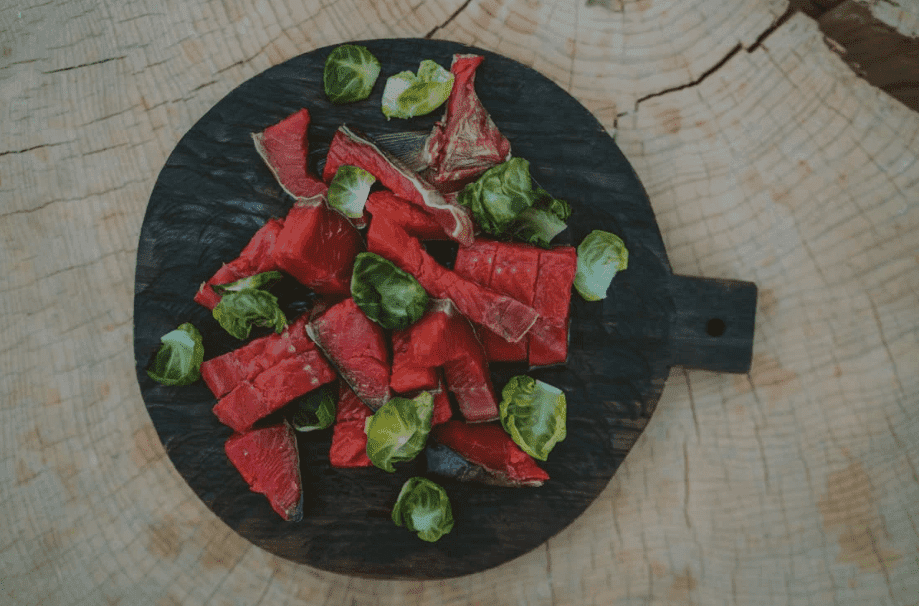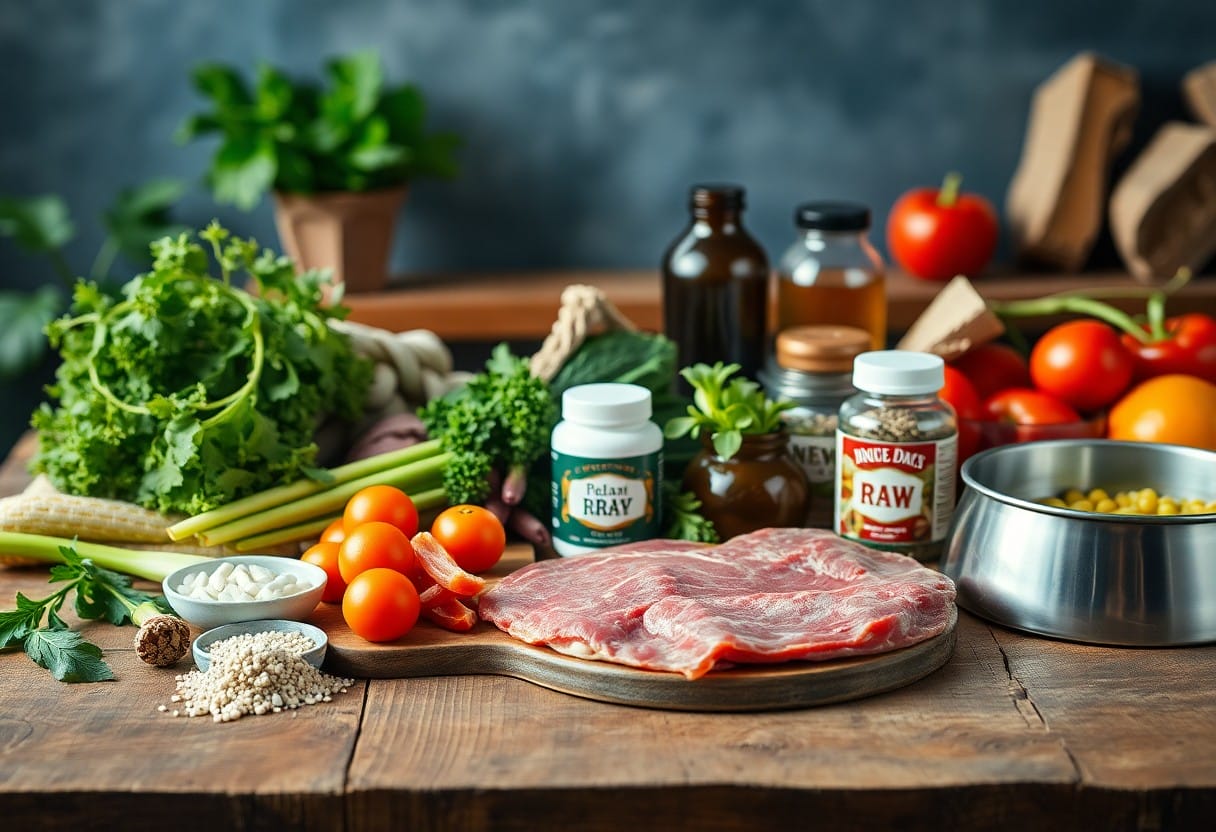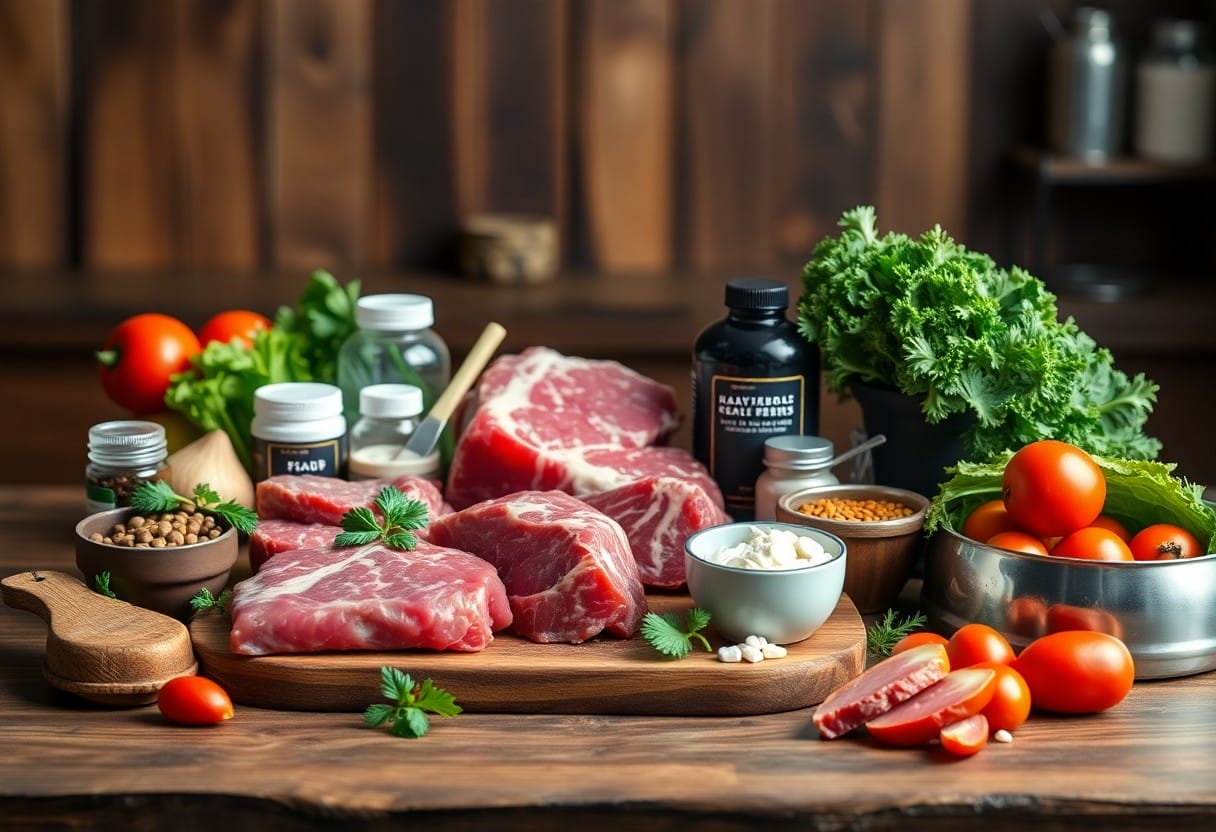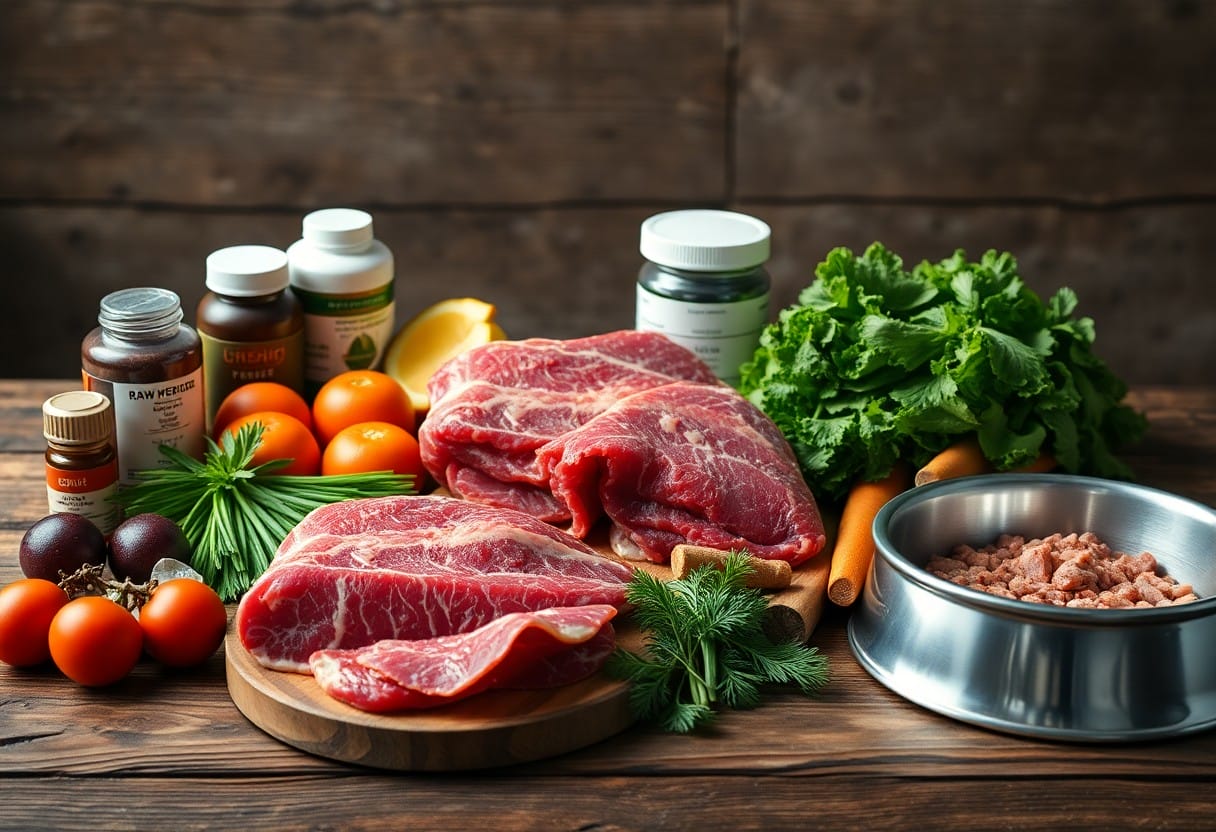
What is raw dog food?
Share
Most dog owners are becoming increasingly aware of the benefits of raw dog food, a diet that consists of uncooked meat, bones, fruits, and vegetables. This approach mimics a natural, ancestral diet for dogs and can lead to improvements in coat shine, dental health, and overall vitality. However, it's important to handle raw food safely to avoid bacterial contamination that could affect both you and your dog. In this post, you'll learn the importants of raw dog food, its pros and cons, and how to transition your pet safely to this feeding method.
Key Takeaways:
- Definition: Raw dog food consists of uncooked ingredients, including meat, bones, organs, and vegetables, aiming to mimic a dog's natural diet.
- Benefits: Proponents argue that raw diets can improve digestion, enhance coat quality, and boost overall health and energy levels.
- Safety Considerations: It's important to handle raw food with care to prevent bacterial contamination and ensure a balanced nutritional profile for dogs.
Understanding Raw Dog Food
For many pet owners, the journey into the world of raw dog food can lead to significant health benefits for their dogs. This natural dietary approach involves feeding dogs a diet based primarily on raw protein sources. Comprising meat, bones, fruits, and vegetables, raw dog food aims to replicate a dog's ancestral diet, promoting improved digestion, healthier coats, and increased energy levels.
Definition and Composition
Food that falls under the category of raw dog food consists mainly of uncooked animal products. This includes meat, bones, organs, fruits, and vegetables. The goal is to provide a balanced diet that mirrors the nutritional content found in a wild dog's diet. It's imperative to ensure that the mixture is appropriately proportioned to meet your dog's individual health needs.
Types of Raw Dog Food
Types of raw dog food can vary based on ingredients and preparation methods. Here are some common types:
- Whole prey
- Pre-packaged raw meals
- Homemade raw diets
- Freeze-dried raw food
- Raw meaty bones
This variety allows you to choose the best option that fits your dog's preferences and dietary requirements.
Types of raw dog food offer specific nutritional advantages tailored to different canine needs. Whole prey diets include entire animals, ensuring a complete nutrient profile. Pre-packaged raw meals provide convenience, while homemade options allow you to customize your dog's diet easily. Freeze-dried options retain nutrients and have long shelf lives. Raw meaty bones offer dental benefits. This allows you to select a type that aligns with your dog's specific health goals and lifestyle.
- Whole prey
- Pre-packaged raw meals
- Homemade raw diets
- Freeze-dried raw food
- Raw meaty bones
This variety makes it easier to accommodate your dog's individual preferences and health needs.
Considering the types of raw dog food, it's important to recognize imperative factors like nutrition balance, potential allergies, and food safety practices. Understanding the composition of these diets will help you in making informed decisions. You should also consult with a veterinarian to ensure that you are meeting your dog's specific dietary requirements.
| Type | Key Detail |
| Whole prey | Includes entire animals for complete nutrition. |
| Pre-packaged raw meals | Convenient option with balanced nutrition. |
| Homemade raw diets | Customizable to your dog's specific needs. |
| Freeze-dried raw food | Long shelf life while retaining nutrients. |
| Raw meaty bones | Supports dental health and nutrient intake. |

Benefits of Raw Dog Food
You may be wondering about the many benefits of raw dog food. This diet can lead to enhanced overall health for your furry friend, improving their energy levels, coat quality, and digestion. Raw food meets the natural dietary needs of dogs, promoting stronger immune systems and a healthier weight, which can result in a happier, more active life.
Nutritional Advantages
Benefits of raw dog food include a balanced mix of proteins, fats, vitamins, and minerals. By feeding your dog real, unprocessed ingredients, you ensure they receive imperative nutrients that support their growth, muscle development, and overall vitality. Many owners report improved skin and coat condition after transitioning to raw food.
Health Improvements
Benefits of raw dog food extend to various health improvements. You may notice a reduction in allergies, better dental health, and a lower risk of obesity. Your dog could experience less digestive upset, leading to firmer stools and increased energy levels as well.
For instance, dogs on a raw diet often experience significant reductions in allergies and skin irritations due to the absence of fillers and artificial ingredients. Additionally, raw diets are linked to improved dental health, as the natural chewing of bones can help reduce plaque buildup. Weight management is another advantage, as raw food tends to be less calorie-dense compared to processed kibble, making it easier for your dog to maintain a healthy weight. These improvements can ultimately lead to a happier, longer life for your furry companion.

Potential Risks and Concerns
Unlike traditional dog food, raw dog food presents certain risks and concerns that pet owners should be aware of. While many advocates highlight the benefits of a raw food diet, it's necessary to consider factors such as potential bacterial contamination and maintaining nutritional balance for your dog's health.
Bacterial Contamination
By feeding your dog raw food, you increase the risk of bacterial contamination from pathogens like Salmonella or E. coli. These bacteria can be harmful not only to your dog but can also pose a risk to your family. It's imperative to ensure proper handling and sanitation of food to minimize these risks.
Nutritional Balance
Any improper balance in your dog's diet can lead to serious health issues. Raw dog food diets can sometimes lack necessary nutrients if not meticulously planned. It's important to conduct thorough research or consult with a veterinarian before making the switch.
Indeed, achieving a proper nutritional balance in your dog's raw food diet is vital for avoiding deficiencies and ensuring optimal health. This means providing a mix of proteins, fats, vitamins, and minerals that meet your dog's specific needs. If your dog's diet isn't well-rounded, they may face health problems such as weakened immune systems, skin issues, and digestive disturbances. Therefore, regularly assess the quality of ingredients you use and consult veterinary professionals to create a safe and effective raw diet that supports your pet's well-being.

Transitioning to Raw Dog Food
Your transition to raw dog food can be a rewarding journey for both you and your furry friend. It's crucial to do your research and understand what you need to know about a raw dog food diet to ensure a seamless changeover.
Gradual Introduction
With any dietary change, it's wise to introduce raw food gradually. Start by mixing a small amount of raw food with your dog's current kibble, and slowly increase the raw portion over several days to minimize digestive discomfort.
Monitoring Health and Behavior
An important part of transitioning is to closely monitor your dog's health and behavior throughout the process.
Further, watch for any signs of digestion issues, such as diarrhea or vomiting, as these may indicate that your dog is reacting to the new diet. Noticeable changes in energy levels or coat quality can signify positive adjustments, while reluctance to eat or lethargy should be considered red flags. Paying attention to your pet's overall wellness can help you fine-tune their raw food diet and ensure they thrive on this new nutritional plan.
Common Misconceptions
Now, when it comes to raw dog food, there are several misconceptions that can lead to confusion. Many people believe that raw diets are inherently unsafe or unbalanced, while others think that they will lead to aggressive behavior in dogs. These myths can deter you from considering raw food, but understanding the facts can help dispel these concerns and allow you to make an informed choice for your furry friend.
Myths vs. Facts
About raw dog food, some myths paint a misleading picture. For instance, while many think a raw diet is too risky or ineffective, it actually offers numerous benefits when properly balanced and handled. Educating yourself about the facts regarding raw feeding can enhance your dog's health and well-being.
Expert Opinions
About raw dog food, veterinary nutritionists and pet experts have varied opinions. Many endorse raw feeding when it's done correctly, emphasizing the importance of a balanced meal that includes appropriate protein and nutrients. Some professionals caution against potential hazards, but most agree that with proper education and care, raw diets can be beneficial for your dog.
For instance, experts note that raw dog food can enhance your pet's coat, energy levels, and overall health, provided it meets their nutritional needs. However, it's important to ensure proper food handling to avoid contamination, as raw meat can harbor bacteria that pose risks to both you and your dog. Consulting with a veterinarian can help you create a safe and effective raw feeding plan, further enhancing your pet's nutrition and health.
Summing up
Now that you understand what raw dog food is, you can confidently explore these diets for your furry friend. Raw dog food typically consists of uncooked meats, bones, fruits, and vegetables designed to mimic a dog's natural diet. By opting for this nutritional approach, you may enhance your dog's health and vitality, although it's necessary to research and consult with a veterinarian to ensure a balanced meal plan that suits your dog's specific needs. Your commitment to understanding raw dog food can lead to a happier, healthier companion.
Frequently Asked Questions
What is raw dog food?
A: Raw dog food is a type of diet that consists of uncooked ingredients, typically including meat, bones, organs, and sometimes fruits and vegetables. This diet aims to mimic what dogs would eat in the wild, focusing on high protein and natural nutrients without the processing involved in traditional kibble or canned food.
What are the benefits of feeding my dog raw food?
A: Proponents of raw dog food often cite various benefits, including healthier skin and coat, improved digestion, increased energy levels, and enhanced dental health. The diet may also contribute to better weight management and a reduction in allergies. However, not all dogs will respond the same way, and individual needs should always be considered.
Are there any risks or concerns associated with raw dog food?
A: Yes, there can be risks involved in feeding raw dog food. Potential issues include the risk of bacterial contamination (like Salmonella or E. coli), nutritional imbalances if not properly prepared, and the possibility of bone splintering or choking hazards. It's important for pet owners to consult with a veterinarian before making dietary changes, especially if their dog has existing health issues.
How can I transition my dog to a raw food diet?
A: Transitioning to raw dog food should be done gradually to allow your dog's digestive system to adjust. Start by mixing small amounts of raw food with their current diet and gradually increasing the proportion of raw food over a week or two. Monitoring your dog's response during this process is important, and you may want to adjust the transition speed based on how they handle the change.
What ingredients should I include in a raw dog food diet?
A: A balanced raw dog food diet typically includes muscle meat, bones, and organ meats as primary protein sources. You can also add small amounts of fruits and vegetables for fiber and additional nutrients. Common choices include chicken, beef, lamb, liver, carrots, and blueberries. It's advisable to consult with a veterinary nutritionist to create a diet that meets all of your dog's nutritional needs.
